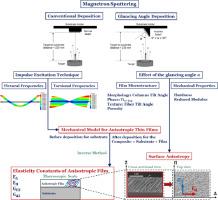当前位置:
X-MOL 学术
›
Int. J. Mech. Sci.
›
论文详情
Our official English website, www.x-mol.net, welcomes your
feedback! (Note: you will need to create a separate account there.)
Elastic behavior of anisotropic coatings sputter-deposited at oblique incidence
International Journal of Mechanical Sciences ( IF 7.1 ) Pub Date : 2021-02-01 , DOI: 10.1016/j.ijmecsci.2020.106050 Elia Zgheib , Akram Alhussein , Mohamed Fares Slim , Khaled Khalil , Manuel François
International Journal of Mechanical Sciences ( IF 7.1 ) Pub Date : 2021-02-01 , DOI: 10.1016/j.ijmecsci.2020.106050 Elia Zgheib , Akram Alhussein , Mohamed Fares Slim , Khaled Khalil , Manuel François

|
Abstract In this work, the elasticity constants of anisotropic thin films were determined using a model developed specifically in order to use the Impulse Excitation Technique (IET). The model is based on the lamination theory and was validated with a finite element analysis. The IET was used in flexural and torsional vibration modes in order to determine the Young's and shear moduli of coatings. The anisotropic behavior was evaluated for titanium thin films deposited by magnetron sputtering at Glancing Angle Deposition (GLAD) on glass substrates and silicon wafers. The elastic response was examined for three different glancing angles and the presence of in-plane anisotropy of the film was noticed from the measured elasticity constants. The difference between conventional and GLAD sputtering was evaluated in terms of microstructure, texture evolution and elastic properties. The influence of the film porosity on the elasticity constants was investigated. Nanoindentation measurements were performed in order to evaluate the effect of the glancing angle on the hardness and the reduced modulus. The results revealed that the elasticity constants of the titanium thin film were mostly affected by the glancing angle and they decreased when the glancing angle increased. The same effect was noticed for the film hardness and reduced modulus. Upon increasing the glancing angle, the film anisotropy was increased owing to different factors, among which the non-standard columnar growth and the inclined crystallites toward the vapor flux direction.
中文翻译:

斜入射溅射沉积各向异性涂层的弹性行为
摘要 在这项工作中,各向异性薄膜的弹性常数是使用为使用脉冲激励技术 (IET) 专门开发的模型确定的。该模型基于层压理论,并通过有限元分析进行了验证。IET 用于弯曲和扭转振动模式,以确定涂层的杨氏模量和剪切模量。对通过磁控溅射以掠射角沉积 (GLAD) 在玻璃基板和硅晶片上沉积的钛薄膜的各向异性行为进行了评估。针对三个不同的掠射角检查弹性响应,并且从测量的弹性常数注意到膜的平面内各向异性的存在。传统溅射和 GLAD 溅射之间的差异是在微观结构方面进行评估的,纹理演变和弹性特性。研究了薄膜孔隙率对弹性常数的影响。进行纳米压痕测量以评估掠射角对硬度和降低的模量的影响。结果表明,钛薄膜的弹性常数主要受掠射角的影响,并且随着掠射角的增加而减小。对于薄膜硬度和降低的模量观察到相同的效果。随着掠射角的增加,薄膜各向异性因不同因素而增加,其中非标准柱状生长和微晶向蒸汽通量方向倾斜。进行纳米压痕测量以评估掠射角对硬度和降低的模量的影响。结果表明,钛薄膜的弹性常数主要受掠射角的影响,并且随着掠射角的增加而减小。对于薄膜硬度和降低的模量观察到相同的效果。随着掠射角的增加,薄膜各向异性因不同因素而增加,其中非标准柱状生长和微晶向蒸汽通量方向倾斜。进行纳米压痕测量以评估掠射角对硬度和降低的模量的影响。结果表明,钛薄膜的弹性常数主要受掠射角的影响,并且随着掠射角的增加而减小。对于薄膜硬度和降低的模量观察到相同的效果。随着掠射角的增加,薄膜各向异性因不同因素而增加,其中非标准柱状生长和微晶向蒸汽通量方向倾斜。结果表明,钛薄膜的弹性常数主要受掠射角的影响,并且随着掠射角的增加而减小。对于薄膜硬度和降低的模量观察到相同的效果。随着掠射角的增加,薄膜各向异性因不同因素而增加,其中非标准柱状生长和微晶向蒸汽通量方向倾斜。结果表明,钛薄膜的弹性常数主要受掠射角的影响,并且随着掠射角的增加而减小。对于薄膜硬度和降低的模量观察到相同的效果。随着掠射角的增加,薄膜各向异性因不同因素而增加,其中非标准柱状生长和微晶向蒸汽通量方向倾斜。
更新日期:2021-02-01
中文翻译:

斜入射溅射沉积各向异性涂层的弹性行为
摘要 在这项工作中,各向异性薄膜的弹性常数是使用为使用脉冲激励技术 (IET) 专门开发的模型确定的。该模型基于层压理论,并通过有限元分析进行了验证。IET 用于弯曲和扭转振动模式,以确定涂层的杨氏模量和剪切模量。对通过磁控溅射以掠射角沉积 (GLAD) 在玻璃基板和硅晶片上沉积的钛薄膜的各向异性行为进行了评估。针对三个不同的掠射角检查弹性响应,并且从测量的弹性常数注意到膜的平面内各向异性的存在。传统溅射和 GLAD 溅射之间的差异是在微观结构方面进行评估的,纹理演变和弹性特性。研究了薄膜孔隙率对弹性常数的影响。进行纳米压痕测量以评估掠射角对硬度和降低的模量的影响。结果表明,钛薄膜的弹性常数主要受掠射角的影响,并且随着掠射角的增加而减小。对于薄膜硬度和降低的模量观察到相同的效果。随着掠射角的增加,薄膜各向异性因不同因素而增加,其中非标准柱状生长和微晶向蒸汽通量方向倾斜。进行纳米压痕测量以评估掠射角对硬度和降低的模量的影响。结果表明,钛薄膜的弹性常数主要受掠射角的影响,并且随着掠射角的增加而减小。对于薄膜硬度和降低的模量观察到相同的效果。随着掠射角的增加,薄膜各向异性因不同因素而增加,其中非标准柱状生长和微晶向蒸汽通量方向倾斜。进行纳米压痕测量以评估掠射角对硬度和降低的模量的影响。结果表明,钛薄膜的弹性常数主要受掠射角的影响,并且随着掠射角的增加而减小。对于薄膜硬度和降低的模量观察到相同的效果。随着掠射角的增加,薄膜各向异性因不同因素而增加,其中非标准柱状生长和微晶向蒸汽通量方向倾斜。结果表明,钛薄膜的弹性常数主要受掠射角的影响,并且随着掠射角的增加而减小。对于薄膜硬度和降低的模量观察到相同的效果。随着掠射角的增加,薄膜各向异性因不同因素而增加,其中非标准柱状生长和微晶向蒸汽通量方向倾斜。结果表明,钛薄膜的弹性常数主要受掠射角的影响,并且随着掠射角的增加而减小。对于薄膜硬度和降低的模量观察到相同的效果。随着掠射角的增加,薄膜各向异性因不同因素而增加,其中非标准柱状生长和微晶向蒸汽通量方向倾斜。











































 京公网安备 11010802027423号
京公网安备 11010802027423号